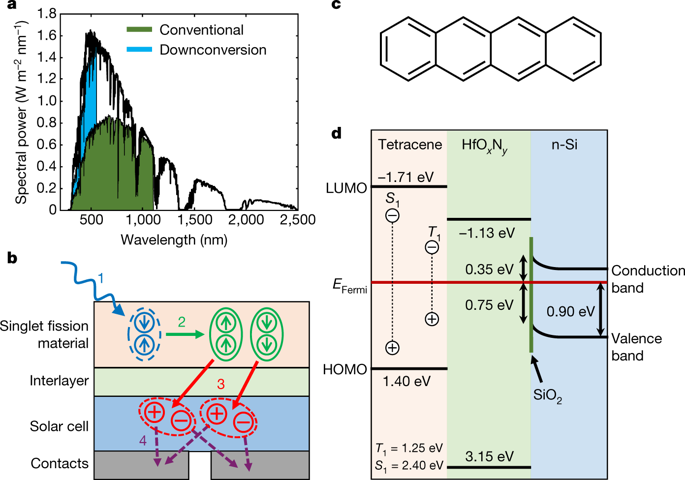Our official English website, www.x-mol.net, welcomes your
feedback! (Note: you will need to create a separate account there.)
Sensitization of silicon by singlet exciton fission in tetracene
Nature ( IF 50.5 ) Pub Date : 2019-07-01 , DOI: 10.1038/s41586-019-1339-4 Markus Einzinger , Tony Wu , Julia F. Kompalla , Hannah L. Smith , Collin F. Perkinson , Lea Nienhaus , Sarah Wieghold , Daniel N. Congreve , Antoine Kahn , Moungi G. Bawendi , Marc A. Baldo
Nature ( IF 50.5 ) Pub Date : 2019-07-01 , DOI: 10.1038/s41586-019-1339-4 Markus Einzinger , Tony Wu , Julia F. Kompalla , Hannah L. Smith , Collin F. Perkinson , Lea Nienhaus , Sarah Wieghold , Daniel N. Congreve , Antoine Kahn , Moungi G. Bawendi , Marc A. Baldo

|
Silicon dominates contemporary solar cell technologies1. But when absorbing photons, silicon (like other semiconductors) wastes energy in excess of its bandgap2. Reducing these thermalization losses and enabling better sensitivity to light is possible by sensitizing the silicon solar cell using singlet exciton fission, in which two excited states with triplet spin character (triplet excitons) are generated from a photoexcited state of higher energy with singlet spin character (a singlet exciton)3–5. Singlet exciton fission in the molecular semiconductor tetracene is known to generate triplet excitons that are energetically matched to the silicon bandgap6–8. When the triplet excitons are transferred to silicon they create additional electron–hole pairs, promising to increase cell efficiencies from the single-junction limit of 29 per cent to as high as 35 per cent9. Here we reduce the thickness of the protective hafnium oxynitride layer at the surface of a silicon solar cell to just eight angstroms, using electric-field-effect passivation to enable the efficient energy transfer of the triplet excitons formed in the tetracene. The maximum combined yield of the fission in tetracene and the energy transfer to silicon is around 133 per cent, establishing the potential of singlet exciton fission to increase the efficiencies of silicon solar cells and reduce the cost of the energy that they generate. A silicon and tetracene solar cell employing singlet fission uses an eight-angstrom-thick hafnium oxynitride interlayer to promote efficient triplet transfer, increasing the efficiency of the cell.
中文翻译:

并四苯中单线态激子裂变对硅的敏化
硅主导着当代太阳能电池技术1。但是当吸收光子时,硅(与其他半导体一样)会浪费超过其带隙 2 的能量。通过使用单重态激子裂变对硅太阳能电池进行敏化,可以减少这些热化损失并提高对光的敏感性,其中两个具有三重自旋特性的激发态(三重激子)由具有单重自旋特性的更高能量的光激发态产生。单线态激子)3-5。已知分子半导体并四苯中的单线态激子裂变会产生与硅带隙 6-8 能量匹配的三线态激子。当三重态激子转移到硅上时,它们会产生额外的电子-空穴对,承诺将电池效率从 29% 的单结限制提高到高达 35%9。在这里,我们将硅太阳能电池表面的氮氧化铪保护层的厚度降低到仅 8 埃,使用电场效应钝化来实现并四苯中形成的三线态激子的有效能量转移。并四苯中的裂变和向硅的能量转移的最大组合产率约为 133%,这表明单线态激子裂变具有提高硅太阳能电池效率并降低其产生的能量成本的潜力。采用单线态裂变的硅和并四苯太阳能电池使用八埃厚的氮氧化铪夹层来促进有效的三线态转移,从而提高电池的效率。
更新日期:2019-07-01
中文翻译:

并四苯中单线态激子裂变对硅的敏化
硅主导着当代太阳能电池技术1。但是当吸收光子时,硅(与其他半导体一样)会浪费超过其带隙 2 的能量。通过使用单重态激子裂变对硅太阳能电池进行敏化,可以减少这些热化损失并提高对光的敏感性,其中两个具有三重自旋特性的激发态(三重激子)由具有单重自旋特性的更高能量的光激发态产生。单线态激子)3-5。已知分子半导体并四苯中的单线态激子裂变会产生与硅带隙 6-8 能量匹配的三线态激子。当三重态激子转移到硅上时,它们会产生额外的电子-空穴对,承诺将电池效率从 29% 的单结限制提高到高达 35%9。在这里,我们将硅太阳能电池表面的氮氧化铪保护层的厚度降低到仅 8 埃,使用电场效应钝化来实现并四苯中形成的三线态激子的有效能量转移。并四苯中的裂变和向硅的能量转移的最大组合产率约为 133%,这表明单线态激子裂变具有提高硅太阳能电池效率并降低其产生的能量成本的潜力。采用单线态裂变的硅和并四苯太阳能电池使用八埃厚的氮氧化铪夹层来促进有效的三线态转移,从而提高电池的效率。


















































 京公网安备 11010802027423号
京公网安备 11010802027423号